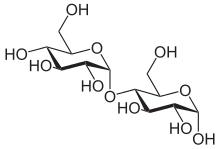Maltose/ja: Difference between revisions
Created page with "{{chembox | Verifiedfields = changed | Watchedfields = removed | verifiedrevid = 47716923 | ImageFile = Maltose2.svg | ImageSize = | ImageName = α-Maltose | ImageCaption = α-Maltose | ImageFile1 = Maltose structure.svg | ImageSize1 = | ImageName1 = β-Maltose | ImageCaption1 = β-Maltose | IUPACName = 4-''O''-α-<small>D</small>-Glucopyranosyl-<small>D</small>-glucose | OtherNames = | SystematicName = (3''R'',4''R'',5''S'',6'..." |
Created page with "甘い味がするが、濃度にもよるが砂糖の30~60%程度しか甘くない。" Tags: Mobile edit Mobile web edit |
||
| (9 intermediate revisions by the same user not shown) | |||
| Line 62: | Line 62: | ||
[[Image:Amylase reaction.png|thumb|right|260px|アミロースを加水分解してマルトースを生成するアミラーゼ反応]] | [[Image:Amylase reaction.png|thumb|right|260px|アミロースを加水分解してマルトースを生成するアミラーゼ反応]] | ||
'''マルトース'''({{IPAc-en|ˈ|m|ɔː|l|t|oʊ|s}}または{{IPAc-en|ˈ|m|ɔː|l|t|oʊ|z}})は、'''マルトビオース'''または'''麦芽糖'''としても知られ、α(1→4)[[glycosidic bond/ja|結合]]で結合した2単位の[[glucose/ja|グルコース]]から形成される[[disaccharide/ja|二糖]]である。[[isomer/ja|異性体]][[isomaltose/ja|イソマルトース]]では、2つのグルコース分子がα(1→6)結合で結合している。マルトースは、[[starch/ja|デンプン]]の重要な構造モチーフである[[amylose/ja|アミロース]][[homologous series/ja|相同系列]]の2単位のメンバーである。[[beta-amylase/ja/ja|β-アミラーゼ]]がデンプンを分解する際、一度に2つのグルコースを除去し、マルトースを生成する。この反応の例は[[germination/ja|発芽]]する種子に見られ、これが[[malt/ja|麦芽]]の名前の由来となっている。[[sucrose/ja|スクロース]]とは異なり、[[reducing sugar/ja|還元糖]]である。 | |||
''' | |||
== 歴史{{Anchor|History}} == | |||
== History == | マルトースは[[:en:Augustin-Pierre Dubrunfaut|Augustin-Pierre Dubrunfaut]]によって発見されたが、この発見は1872年にアイルランドの化学者であり醸造家でもある[[:en:Cornelius O'Sullivan|Cornelius O'Sullivan]]によって確認されるまで広く受け入れられることはなかった。名称は[[malt/ja|麦芽]]に由来し、糖類の名称に用いられる接尾辞「[[-ose/ja|-ose]]」と組み合わされている。 | ||
== 構造と命名法{{Anchor|Structure and nomenclature}} == | |||
== Structure and nomenclature == | 炭水化物は一般に、糖のサブユニットの数によって[[monosaccharide/ja|単糖]]、[[oligosaccharide/ja|オリゴ糖]]、[[polysaccharide/ja|多糖]]に分けられる。2つの糖単位を持つマルトースは二糖類であり、オリゴ糖に該当する。グルコースは[[hexose/ja|ヘキソース]]であり、6個の炭素原子を含む単糖である。2つのグルコース単位は[[pyranose/ja|ピラノース]]の形をしており、[[glycosidic bond/ja|O-グリコシド結合]]で結合している。最初の[[glucose/ja|グルコース]]の最初の炭素(C<sub>1</sub>)は、2番目の[[glucose/ja|グルコース]]の4番目の炭素(C<sub>4</sub>)に結合しており、(1→4)と示される。アノマー炭素(C<sub>1</sub>)へのグリコシド結合は{{chem|C|H|2|O|H}}とは反対側の平面にあるため、この結合はαとして特徴づけられる。同じ環の[[substituent/ja|置換基]](最初のグルコースのC<sub>6</sub>)とは反対面にある。アノマー炭素(C<sub>1</sub>)へのグリコシド結合が{{chem|C|H|2|O|H}}置換基と同一平面上にあった場合、それは'''β(1→4)'''結合として分類され、結果として得られる分子は[[cellobiose/ja|セロビオース]]となる。グリコシド結合に関与しない2番目のグルコースのアノマー炭素(C<sub>1</sub>)は、同じ環の{{chem|C|H|2|O|H}}置換基に対する結合した水酸基の結合方向によって、α-アノマーにもβ-アノマーにもなり、α-マルトースにもβ-マルトースにもなる。 | ||
マルトースの[[isomer/ja|異性体]]に[[isomaltose/ja|イソマルトース]]がある。これはマルトースと似ているが、α(1→4)位の結合の代わりにα(1→6)位に結合しており、[[glycogen/ja|グリコーゲン]]や[[amylopectin/ja|アミロペクチン]]の分岐点に見られる結合と同じである。 | |||
== 特性{{Anchor|Properties}} == | |||
== Properties == | グルコースと同様、マルトースは[[reducing sugar/ja|還元糖]]である。なぜなら、2つのグルコースユニットのうち1つの環は開いて遊離の[[aldehyde/ja|アルデヒド]]基を提示することができるが、もう1つの環はグリコシド結合の性質上提示することができないからである。マルトースは、グリコシド結合の加水分解を触媒する[[maltase/ja|マルターゼ]]酵素によってグルコースに分解することができる。 | ||
水溶液中のマルトースは[[mutarotation/ja|変異回転]]を示すが、これはアノマー炭素の異なるコンフォーメーションによって形成されるα異性体とβ異性体が異なる[[specific rotation/ja|比回転]]を持つためであり、水溶液中ではこれら2つの形態は平衡状態にある。マルトースは、メチルアミンに対するWoehlk試験やFearon試験で容易に検出できる。 | |||
甘い味がするが、濃度にもよるが砂糖の30~60%程度しか甘くない。 | |||
== 供給源と吸収{{Anchor|Sources and absorption}} == | |||
== Sources and absorption == | [[Image:Maltose syrup.jpg|thumb|right|マルトースシロップ]] | ||
[[Image:Maltose syrup.jpg|thumb|right| | 麦芽糖は[[malt/ja|麦芽]]の成分であり、穀物を水で柔らかくし、発芽させたときに得られる物質である。また、[[maltodextrin/ja|マルトデキストリン]]、[[corn syrup/ja|コーンシロップ]]、酸で薄めた澱粉のような部分加水分解澱粉製品にも非常に様々な量で含まれている。 | ||
植物以外では、マルトースは[[sugarbag/ja|シュガーバッグ]]にも含まれている(と思われる)。 | |||
ヒトでは、マルトースは様々なマルターゼ酵素によって分解され、エネルギーを供給するために分解されるか、グリコーゲンとして貯蔵される[[glucose metabolism/ja|さらに処理される]]ことができる2つのグルコース分子を提供する。ヒトにおいて[[sucrase-isomaltase/ja|スクロースイソマルターゼ]]酵素が欠損していると[[sucrose intolerance/ja|スクロース不耐症]]を引き起こすが、4つの異なるマルターゼ酵素が存在するため、完全なマルトース不耐症は極めてまれである。 | |||
==外部リンク== | |||
*{{Commons category-inline}} | *{{Commons category-inline}} | ||
*[https://web.archive.org/web/20051124215824/http://www.elmhurst.edu/~chm/vchembook/546maltose.html Maltose], Elmhurst College Virtual Chembook. | *[https://web.archive.org/web/20051124215824/http://www.elmhurst.edu/~chm/vchembook/546maltose.html Maltose], Elmhurst College Virtual Chembook. | ||
{{Carbohydrates/ja}} | |||
{{Carbohydrates}} | {{Sugar/ja}} | ||
{{Sugar}} | |||
[[Category:Disaccharides]] | [[Category:Disaccharides]] | ||
[[Category:Starch]] | [[Category:Starch]] | ||
[[Category:Sugars]] | [[Category:Sugars]] | ||
[[Category:Malt]] | [[Category:Malt]] | ||
Latest revision as of 20:17, 21 April 2024
 α-Maltose
| |
 β-Maltose
| |
| Names | |
|---|---|
| IUPAC name
4-O-α-D-Glucopyranosyl-D-glucose
| |
| Systematic IUPAC name
(3R,4R,5S,6R)-6-(hydroxymethyl)-5-{[(2R,3R,4S,5S,6R)-3,4,5-trihydroxy-6-(hydroxymethyl)oxan-2-yl]oxy}oxane-2,3,4-triol | |
| Identifiers | |
3D model (JSmol)
|
|
| ChEBI | |
| ChEMBL | |
| ChemSpider | |
| EC Number |
|
| KEGG | |
PubChem CID
|
|
| UNII | |
| |
| |
| Properties | |
| C12H22O11 | |
| Molar mass | 342.297 g·mol−1 |
| Appearance | White powder or crystals |
| Density | 1.54 g/cm3 |
| Melting point | 160 to 165 °C (320 to 329 °F; 433 to 438 K) (anhydrous) 102–103 °C (monohydrate) |
| 1.080 g/mL (20 °C) | |
Chiral rotation ([α]D)
|
+140.7° (H2O, c = 10) |
| Hazards | |
| Safety data sheet (SDS) | External MSDS |
| Related compounds | |
Related
|
Sucrose Lactose Trehalose Cellobiose |

マルトース(/ˈmɔːltoʊs/または/ˈmɔːltoʊz/)は、マルトビオースまたは麦芽糖としても知られ、α(1→4)結合で結合した2単位のグルコースから形成される二糖である。異性体イソマルトースでは、2つのグルコース分子がα(1→6)結合で結合している。マルトースは、デンプンの重要な構造モチーフであるアミロース相同系列の2単位のメンバーである。β-アミラーゼがデンプンを分解する際、一度に2つのグルコースを除去し、マルトースを生成する。この反応の例は発芽する種子に見られ、これが麦芽の名前の由来となっている。スクロースとは異なり、還元糖である。
歴史
マルトースはAugustin-Pierre Dubrunfautによって発見されたが、この発見は1872年にアイルランドの化学者であり醸造家でもあるCornelius O'Sullivanによって確認されるまで広く受け入れられることはなかった。名称は麦芽に由来し、糖類の名称に用いられる接尾辞「-ose」と組み合わされている。
構造と命名法
炭水化物は一般に、糖のサブユニットの数によって単糖、オリゴ糖、多糖に分けられる。2つの糖単位を持つマルトースは二糖類であり、オリゴ糖に該当する。グルコースはヘキソースであり、6個の炭素原子を含む単糖である。2つのグルコース単位はピラノースの形をしており、O-グリコシド結合で結合している。最初のグルコースの最初の炭素(C1)は、2番目のグルコースの4番目の炭素(C4)に結合しており、(1→4)と示される。アノマー炭素(C1)へのグリコシド結合はCH
2OHとは反対側の平面にあるため、この結合はαとして特徴づけられる。同じ環の置換基(最初のグルコースのC6)とは反対面にある。アノマー炭素(C1)へのグリコシド結合がCH
2OH置換基と同一平面上にあった場合、それはβ(1→4)結合として分類され、結果として得られる分子はセロビオースとなる。グリコシド結合に関与しない2番目のグルコースのアノマー炭素(C1)は、同じ環のCH
2OH置換基に対する結合した水酸基の結合方向によって、α-アノマーにもβ-アノマーにもなり、α-マルトースにもβ-マルトースにもなる。
マルトースの異性体にイソマルトースがある。これはマルトースと似ているが、α(1→4)位の結合の代わりにα(1→6)位に結合しており、グリコーゲンやアミロペクチンの分岐点に見られる結合と同じである。
特性
グルコースと同様、マルトースは還元糖である。なぜなら、2つのグルコースユニットのうち1つの環は開いて遊離のアルデヒド基を提示することができるが、もう1つの環はグリコシド結合の性質上提示することができないからである。マルトースは、グリコシド結合の加水分解を触媒するマルターゼ酵素によってグルコースに分解することができる。
水溶液中のマルトースは変異回転を示すが、これはアノマー炭素の異なるコンフォーメーションによって形成されるα異性体とβ異性体が異なる比回転を持つためであり、水溶液中ではこれら2つの形態は平衡状態にある。マルトースは、メチルアミンに対するWoehlk試験やFearon試験で容易に検出できる。
甘い味がするが、濃度にもよるが砂糖の30~60%程度しか甘くない。
供給源と吸収

麦芽糖は麦芽の成分であり、穀物を水で柔らかくし、発芽させたときに得られる物質である。また、マルトデキストリン、コーンシロップ、酸で薄めた澱粉のような部分加水分解澱粉製品にも非常に様々な量で含まれている。
植物以外では、マルトースはシュガーバッグにも含まれている(と思われる)。
ヒトでは、マルトースは様々なマルターゼ酵素によって分解され、エネルギーを供給するために分解されるか、グリコーゲンとして貯蔵されるさらに処理されることができる2つのグルコース分子を提供する。ヒトにおいてスクロースイソマルターゼ酵素が欠損しているとスクロース不耐症を引き起こすが、4つの異なるマルターゼ酵素が存在するため、完全なマルトース不耐症は極めてまれである。
外部リンク
 Media related to Maltose/ja at Wikimedia Commons
Media related to Maltose/ja at Wikimedia Commons- Maltose, Elmhurst College Virtual Chembook.